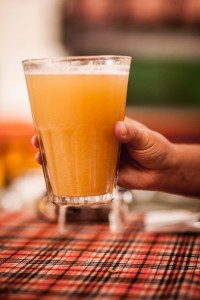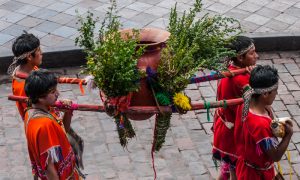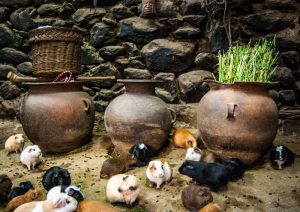Ceramic Raquis Rule for Making Chicha

Incas transported chicha from one place to another in raquis, large pottery vases, so they could have it to drink during days of hard work and during times of need. They carried the raquis on their backs, tied with ropes, to get it to its destination. The raquis also served to process and store the beverage.
During Inca times when the empire connected with nature and promoted harmony and balance among people, chicha was the drink that made Inca culture dynamic.

Chicha was made in great quantities, enough to supply the entire empire. For this they needed many containers (raquis) in order to elaborate chicha in different shapes and forms for different purposes and uses.
Raquis are still known by this name from Quechua, although we also use Spanish words such as cántaros and vasijas. They are large containers made from clay and colored beige or rouge. On the raquis you can see designs that represent the culture.
Raquis tended to be in different shapes. Some were and are conical in shape, not unlike a top. They are still used as vessels in which to ferment chicha. The raquis with wide necks are used to transport chicha. Smaller raquis are used, even today, for transporting the beverage. Each has a particular decoration with stylized and minimalist geometric shapes.


Besides holding chicha, raquis were also used to keep and maintain water. Even today, you will find raquis semi buried in the ground for chicha fermentation. The use of these ceramics is necessary, they say, for a quality product, in chicherías throughout the city of Cuzco as well as in the surrounding countryside. Within the places where chicha is sold we generally find a pair of raquis, half below ground. Each has this drink made from corn. They are also a kind of decoration that gives life and authenticity to these rustic places that are so central to Cuzco’s gastronomic heritage.

If you wish to see raquis, besides visiting a neighborhood chichería, you can go to the Mueso Inca (the Inca Museum). In one of its rooms you will see a variety of raquis, and other pottery containers, in different shapes and sizes. They were used for our ancestral drink. In the museum’s patio you will find the top shaped raqui with surprising and complex designs.
The town of Raqchi, Canas Province, is where there is a very rich tradition of making ceramics. It is its passion. The people of Raqchi are famous, from time immemorial for their pottery work and they still make raquis today.




